5 KEY REASONS TO ADOPT SALESFORCE LWC
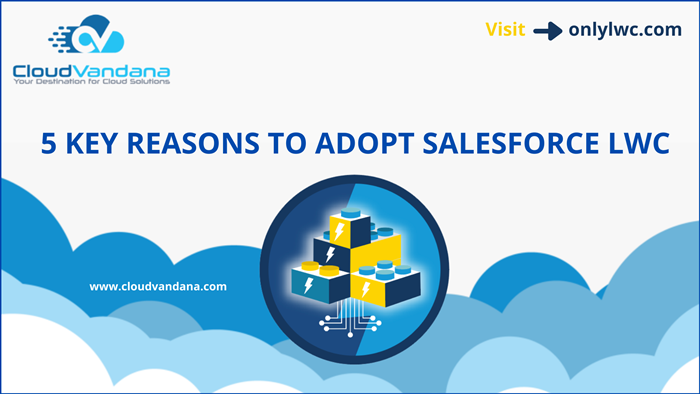
Lightning Web Component (LWC) was introduced in December 2018. Salesforce LWC increases the usability of UI development. Developers who are new and familiar with a few primary frontend languages like Visualforce Pages can start using this framework without any in-depth knowledge of Aura Components or Lightning Components. As LWC uses modern JavaScript frameworks, developers who know only Node.JS or React can easily create code in LWC. Salesforce is appreciated across the globe as it provides a customized solution to every kind of business. So, the developers need to learn the tools very effectively to offer a personalized solution. But thankfully, in LWC., the requirements for technical skillset are not highly framework specific. In this blog, CloudVandana discusses the critical reasons for LWC adoption. 1. Low Code Development Lightning Web Components helps developers build web applications using standard-based tools to simplify the development process. Developers do not need any complex code to develop these web applications. These low-code and no-code functionalities have made this framework easy to adopt. 2. Better security Of Salesforce LWC LWC provides better security services with the help of Lightning Locker. Lightning Locker is a security architecture for Lightning components. This service is automatically enabled to all custom Lightning Web Components. So developers can experience the complete security of their Lightning Web Components. 3. Co-Existence Of Aura & LWC Aura and LWC can exist on this platform side by side. Sometimes, Aura and LWC can even be merged on a page and share the data. In addition, these two components can communicate with the child components or other Aura components. For example, LWC utilizes Custom Events to communicate with Aura components and interacts with its child components through public APIs. 4. Less Complicated Framework When LWC was not introduced, web developers had to learn the Aura components to build the Lightning components. During the introduction of the Lightning framework, this leading CRM was looking for a programming model that could support large-scale client-side applications. Aura was then introduced to keep the Lightning framework, but Aura had a few limitations. For example, Javascript frameworks were not transferable to Aura. As a result, LWC was introduced, which focuses more on web standards than a complicated framework. As a result, it has become more convenient for developers who know the Javascript framework to work on LWC. 5. Enhanced Testing And Support Facebook created a practical open-source framework for writing Javascript tests. Through this extension, developers can write unit tests for Lightning web components. These are the five critical reasons developers adopt the Lightning Web Component framework. Are you looking for experienced LWC developers? Please feel free to contact CloudVandana to get unlimited LWCs at a flat rate. For more information, visit onlylwc.com. Request a Free Consultation YOU MIGHT ALSO LIKE
What is Salesforce CDP? Why is CDP needed?

Salesforce CDP is a self-service customer data platform. As marketers grasp our customers, good data is required to create excellent customer relationships. It is crucial to deliver personalized cross-channel engagement to customers and deliver unified data. Unified information is essential for a marketer’s warehouse to personalize at scale. A one-to-one relationship with the customer is an integral part of marketing nowadays. Many companies aren’t providing that sort of data solution which provides the marketers what they need to earn as ROI from personalization initiatives. Instead, most companies develop their marketing clouds and engagement channels with action at the forefront. After years of addressing delivering experiences across an effective form of applications from email to websites to mobile, marketing clouds like Salesforce, Adobe and Oracle have all announced that they’re building their customer data platforms (CDPs). In today’s world, no customer believes in compromising for a quality experience. The Salesforce Customer Data Platform helps a lot to earn and construct customer loyalty. Using new techniques, Salesforce CDP improves the performance of your business. Daily, there is a data flow from different sources, which is challenging to manage and maintain. A CDP is a collection of software that creates a unified database for customers. The Salesforce Customer Data Platform helps secure the data collected in all possible ways. For whom Salesforce CDP is useful. The primary purpose of Salesforce is to bring together all moving parts of a company using the cloud. If a company is working with different sources to collect data, store, and generate understandings and triggers for marketing actions and campaigns, then Salesforce CDP can be an excellent help. Salesforce CDP determines specific roles spread across your company like marketing manager, data specialist, and so on. A person with intelligent knowledge of data is most suitable to work with Salesforce CDP. Features of Salesforce CDP. Salesforce CDP productively and quickly unifies all of the minute behaviors of the customers across any channel. A single compilation is only necessary for a customer’s activity and engagement by this feature. This kind of data can then be analyzed and updated based on customers’ behavior. By activating this data to a targeted audience, your reach to future customers and the existing customers will increase. We can define a set of rules, and with the help of artificial intelligence, this kind of unification is achieved. Salesforce CDP is very well suited with other business software systems many companies use. Tools like Salesforce Marketing Cloud, Service Cloud, Interaction Studio, Commerce Cloud, Datorama, Loyalty Management, and many more are accessible from Salesforce CDP. Using the “Native connectors,” the customers using Salesforce products can already access Salesforce CDP instantly. With the help of native connectors, we can integrate Salesforce CDP without custom coding. In addition to native connectors, Salesforce CDP integrates with AWS cloud through “S3 Bucket”. This kind of integration will be helpful for those who refresh or update data daily. Conditions and data can change anytime. Like Salesforce CRM, Salesforce CDP helps you maintain easy manipulation and editing of data model objects. Another feature of Salesforce CDP is that it helps to save time by duplicating and transferring existing segments with their full description, perceptions, and filters. Salesforce CDP is an excellent benefit, and future buyers will find this an added asset in the complexity. It supports all Salesforce standard Languages, giving worldwide connectivity. However, it needs regular maintenance to run smoothly. There is not much need for any technical experience like any other CDP system. This helps the companies with less support of IT departments to choose Salesforce CDP. Are you looking for a customized Salesforce solution for your organization? Then, please feel free to take a consultation call with CloudVandana to get started. Request a Free Consultation YOU MIGHT ALSO LIKE
5 KEY BENEFITS OF ARTIFICIAL INTELLIGENCE

Artificial intelligence or AI is the functionality of a computer system controlled by another master system to perform tasks usually done by humans as they need human intelligence. In today’s digital world, the domain of software testing should develop innovative and well-researched testing techniques. To complete this process correctly, AI-based testing has proven very effective. Furthermore, the artificial intelligence process is expanding daily, so testers acknowledge its effectiveness in making complex and time-consuming processes easy. In this blog, CloudVandana will describe the key benefits of artificial intelligence. 1. Enhanced Adaptability Traditional testing scenarios require a single selector. As a result, even small changes in an application can trigger test failures in automation tools. On the other hand, artificial intelligence (AI) based testing provides a flexible testing environment by finding the links between various documents. 2. Complete Coverage AI increases the functionalities of the experiments. It can inspect file contents, data tables, and internal functionalities to check the programs that are not working correctly. AI-powered test automation can test thousands of cases in a single test run, which is simply not possible through manual testing. It also increases the testing procedure. AI can analyze the behavior of the database following an expected output. As it can do multiple tests in a single test run, it can provide complete coverage to the test process. 3. Easy Adaptability Artificial intelligence is a flexible testing approach that links various documentation elements. With the growing technology, organizations are increasingly implementing agile and DevOps strategies. So as these technologies are more adopted, the requirement for robust tools is also increasing, allowing continuous testing and release. With the help of artificial intelligence, businesses are becoming faster in software testing. 4. Saves Efforts And Money When source code changes, software tests reruns, but when this process is done manually, it can be time-consuming and complex, and a lot of effort is required from the testers. But Artificial intelligence automates these tasks correctly and efficiently, so the process reduces the testers’ time, money, and actions. 5. Consistent Testing Experienced testers can find out the issues associated with testing and resolve them. But still, there is a chance of human error. Artificial intelligence is unaffected by duplicate testing. As a result, the outcome becomes more accurate and consistent. Thus, AI eliminates such human interactions to avoid delays in testing. Are you looking for automated business solutions for your organizations? Please take a look at www.cloudvandana.com and get a customized Salesforce solution for your organization. Request a Free Consultation YOU MIGHT ALSO LIKE
LWC vs. SALESFORCE AURA

Salesforce introduced Lightning Web Components (LWC) in December 2018, which has moved this Salesforce platform a step closer to using web standards for UI development. Developers with basic knowledge of Visualforce Pages can start working with LWC without correctly understanding Lightning Components. LWC uses modern Javascript Frameworks. As a result, any developer who has knowledge of Node.JS or React. JS can easily code in the LWC platform. Though Aura and LWC can co-exist in the ecosystem, developers are more interested in migrating the Aura Framework to Salesforce LWC. So they are seeking to know the benefits and functionalities associated with this new component. This article, CloudVandana, will discuss the differences between Aura Component and Salesforce LWC. Following are the differences in features between the two-component to make development easy and increase business value. Use Of Native Browser APIs Since the introduction of Lightning Experience, the component is continuously contributing to web standards. As per the evolution of web standards, browser vendors implement them in native browser APIs. Salesforce keeps changing the functionalities to meet with significant browser vendors for priorities alignment. Aura framework used a proprietary component model, language extensions, and modules, but LWC uses web stack features that browsers implement natively. So it is clear to state that LWC web apps are substantially more effective. Uses Moden Javascript Framework Javascript includes various frameworks such as modules, classes, promises, template literals, decorators, etc. LWC supports all these Javascript features. Javascript is not only a powerful scripting language but also has a considerable contribution to server-side development. The typical web standards properties in LWC make it easier to find developers with Javascript technology expertise. Portability As Salesforce LWC is an open-source platform capable of aligning with web standards, it can quickly work outside the platform. For example, developers can write a component on the platform and reuse that component somewhere else. Backward Compatibility Developers don’t need to worry about backward compatibility while deploying LWC-based web applications to a larger audience across browsers. Why Developers Should Choose LWC Instead of Aura Components Better Functionality No abstraction layer is added to LWC; this component renders faster than the Aura component and provides enhanced performance. Easy-To-Learn LWC adopts native web standards, so it does not require any extra layer like Aura Framework, as we discussed before. Its development only depends on standard Javascript. So developers can quickly adopt this component without any complexity. Developers do not need any additional framework to develop LWC, so the transition is more straightforward. Faster Loading It is a lightweight framework built on web standards. So LWC is faster in loading than Aura components. Service Components Developers can write components that have no user interface in LWC. Then, later on, those components can be reused in other components. There are various other differences between the Aura component and LWC. An experienced LWC developer can guide an organization with the best practices. CloudVandana, the renowned Salesforce partner, has launched a new service, “ LWC Developers as a Service.” Organizations can hire Unlimited LWC Resources at a flat rate. Sounds interesting? Then please check out our landing page onlylwc.com, and hire remote Salesforce LWC developers. Request a Free Consultation YOU MIGHT ALSO LIKE
Building Custom Components with Salesforce LWC Structure
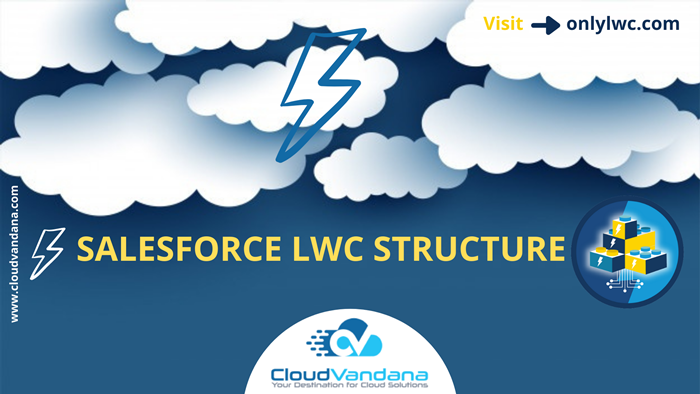
Salesforce has introduced the Lightning web components or Salesforce LWC as the AURA framework previously used for Lightning Components was outdated. Salesforce Lightning Web Component is a new programming model supporting current web standards. It is a flexible framework that supports the common web standards and consists of a layer of functionalities that helps this component be the best fit for UI implementations in Salesforce. The thin layer of various services contains Lightning Data Services, Base Lightning Components, and User interface API that works on LWC. Aura Component Uses must be curious to know the future of Aura components. Aura component and LWC will be staying together, and they are a perfect match for each other. Aura and LWC communicate with each other, so users do not experience any gap in the functionalities when both the components are implemented. Users can include LWC inside AURA Component, but it is not recommended to have Aura Component inside LWC as Aura is a custom framework, whereas LWC is a generic one. Aura and LWC share similar Salesforce essential features like Lightning Locker, Lightning Data Services, and other Lightning Components. The main difference is that Aura was built on ECMAScript 5, whereas LWC is built on ECMAScript 7 version. LWC opens up new ways to enhance the Lightning components. But users can still use the Aura programming model to create a UI framework. LWC Structure Users need to set up Salesforce DX to develop LWC and use all the functionalities to the fullest. First, programmers need to set up the developer environment with the help of a few tools like Visual Studio Code and Salesforce Command Line Interface. The primary elements of an LWC are HTML and Javascript. CSS comes here as optional content. Let’s have a look at the components in detail. HTML Javascript Configuration CSS Component UI Developers can try building the UI component in the VS code setup and deploy it to the org later. Developers can set up the VS code through the help of Salesforce guidelines or an expert LWC developer. Are you looking for experienced LWC developers? Please contact CloudVandana and get unlimited Salesforce LWC at a flat rate. For details, please check out our landing page onlylwc.com. Request a Free Consultation YOU MIGHT ALSO LIKE
SALESFORCE LIGHTNING WEB COMPONENTS-AN OVERVIEW

Salesforce Lightning Web Components (LWC) is a new addition to the Salesforce platform. It helps the Salesforce Lightning Platform a step forward to UI development by using web standards. LWC has brought an extensive change in the Lightning platform programming. This addition is like a ‘cherry on the top’ for the developers working with HTML and Javascript outside Salesforce. In this blog, CloudVandana will describe an overview of LWC, Salesforce Lightning Components, and its benefits. Lightning Web Components LWC is an updated version of developing Salesforce Lightning components. This UI framework is based on HTML and Javascript. Previously Lightning Components were created by the Aura component framework. But recently, it has been developed by a new framework. Lightning Components uses core web component standards and holds custom elements, decorators, modules, templates, and shadow DOM. The Functions Of LWC Developers need to focus on the invention of LWC, where Salesforce had the Aura Component framework. Previously, the Aura programming model only offered a specific foundation for the entire stack. So the programmers were searching for large-scale web applications. However, a variety of elements were missing from the web standards. As a result, the web stacks were not effective in helping the developers create UI components. Besides Aura, many other frameworks like Angular and React came to the field, but various key elements were missing again. These challenges influenced the developers to create UI components. Developers can check the templates, custom elements, and shadow DOM modules as part of the web stack. The latest web stack is so powerful that programmers do not need an additional framework layer in-between that can harm the component functionalities. So these are the main reasons behind the invention of the LWC framework. LWC comes along with various lightning components, with multiple base components that are the parts of the LWC framework. UI components can be created depending on these base components. The Benefits Of LWC Let’s have a look at the benefits of LWC to boost businesses. Enhanced Performance The main advantage of LWC is it delivers exceptional performance. The incoming data can be manipulated while working in the LWC Javascript controller Javascript. Therefore, developers can display the same whenever needed. So they do not require a service call. In addition, as they have an updated DOM render engine, developers will experience a higher speed in component rendering than Aura components. Faster Development Salesforce Lightning Web Components helps the users develop generic components for absolute performance. This implementation allows the admins to drag and drop the Lightning App builder on the required pages while using a generic element. By using LWC, admins can avoid ViewState Error and experience a two-way binding process. As a result, businesses are deploying LWC into their respective frameworks. Similarity LWC delivers a seamless experience to users, deploying responsive designs. This component supports advanced technologies like CSS3, HTML5, and touch events. In addition, it enables business owners to customize the respective elements as per their requirements. Are you looking for experienced LWC developers? Please feel free to contact CloudVandana or visit the page onlylwc.com. Request a Free Consultation YOU MIGHT ALSO LIKE
5 KEY ADVANTAGES OF LARAVEL DEVELOPMENT
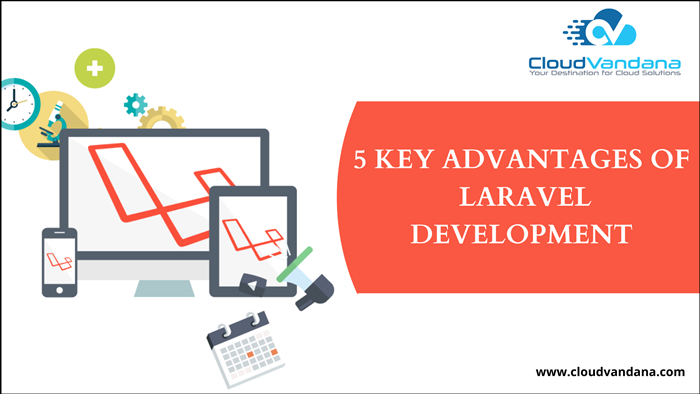
Laravel is an open-source PHP web framework with expressive and elegant syntax. PHP framework is a platform for web applications. This platform expands the opportunities for web apps. As a result, every web application development organization prefers PHP frameworks for its web projects. Various PHP frameworks are available in the industry, such as Laravel, CodeIgniter, Symfony, CakePHP, etc. In this blog, CloudVandana will describe the critical advantages of Laravel development as it is considered the best one among the other web apps. Developers experience various challenges to make the desired web development tasks such as authentication, sessions, routing, etc. PHP Laravel can efficiently resolve those challenges and provide an enhanced experience to the developers. Now, let’s have a look at the benefits of the Laravel Development framework. 1. Highly Secured Nowadays, cyber-attacks are taking place very frequently. So the developers should use a framework that can protect the web applications from these attacks. Laravel provides high-class security to web applications, so developers do not need to worry about safety and can focus on the app’s functionalities. Furthermore, being a secured framework, Laravel does not allow any threats to enter into the application. 2. Strong Authentication Process Authentication for web applications is a challenging functionality for developers. But Laravel simplifies the process by providing access to the authorized users only. 3. Amplified Performance Laravel delivers excellent support to web applications. This framework comes up with various tools to enhance the performance of the apps that can be affected by multiple factors. Developers just need to integrate a few agencies within this framework during development. So, with the help of Laravel, developers can experience the highest-performing web app. 4. Database Migration Through the Laravel framework, the database can be easily migrated. The migration process allows the developers to rectify or undo the changes to the database. In addition, developers can share the databases within the team without any hassle. This helps the developers to boost productivity. Migration pairing ensures that the databases are created efficiently, which saves the developers time for web app development. 5. Easy-Coding Laravel framework is built with libraries, tools, and various templates that make web development tasks easy for developers. Without any complicated codes, they can easily make the applications powerful. These are some of the advantages of Laravel development. Many other excellent benefits can be experienced by hiring an experienced Laravel Developer. If you are looking for an expert Laravel expert, please feel free to contact CloudVandana and take your organization to the next level. Request a Free Consultation YOU MIGHT ALSO LIKE
5 KEY REASONS TO SELECT A SALESFORCE SUPPORT AND MAINTENANCE PARTNER

Salesforce is a cloud-based CRM platform that helps organizations track customer cases and manage tasks and events. It simplifies the communication between an organization and its customers. Salesforce enhances an organization in various ways, but proper implementation and maintenance are required to achieve all the highest benefits of this customer relationship management platform. Today, in this article, CloudVandana will describe the five key reasons to hire a Salesforce support and maintenance partner to ensure the correct implementation and desired success of an organization. 1. Implementation To Deploy A registered Salesforce partner like CloudVandana provides an end-to-end solution from implementation to deployment in a very efficient way. So organizations do not need to take the pressure of that technical procedure and can concentrate on their core businesses. 2. Data Manipulation A support and maintenance partners can help the companies by manipulating data to achieve a better result from the platform and assist the organizations to take full advantage of this platform. 3. Customized Solutions Salesforce does not believe in the ‘one size fits all,’ technique. The platform provides customized solutions depending on the requirements and the size of the organization. A registered partner recommends and implements the best practices that suit the most to an organization. An expert partner like CloudVandana can recommend the best solution to boost the business process. For example, an -e-commerce brand should implement the commerce cloud platform. But there are various tools and best practices that will automate the whole process, update about the customers’ journey, etc which is only possible with the support of a registered partner. 4. User Adoption And Backup If any organization is planning to migrate the present CRM system with Salesforce, then hiring an experienced support and maintenance expert is very much necessary to avail the best results. Migration leads to scattered data and files. Which finally interrupts the whole organizational process. In addition, employees keep on using some of the old tools due to lack of adoption, so they become unable to experience the seamless experience that Salesforce offers. A registered partner takes care of the backup so that employees can resume work just after the migration process without any disruption. Similarly, they provide proper training and adoption support so that employees do not face any challenges while working on this platform. This is important to mention that Salesforce releases three updates per year to modify the ecosystem and serve the customers better. So without a consulting company, it is challenging to update the new addition. 5. More Economic The service of the registered partners is more economic than the services provided by Salesforce. Specifically, if a company can adopt the outsourcing process, it will be much more beneficial as well as cost-effective. CloudVandana provides a huge range of staff augmentation services that companies can experience by hiring an expert professional for the best support and maintenance. Are you looking for an experienced professional to take care of your Salesforce ecosystem? Don’t hesitate to take a free consultation call now. Request a Free Consultation YOU MIGHT ALSO LIKE
What is Salesforce Data Studio?
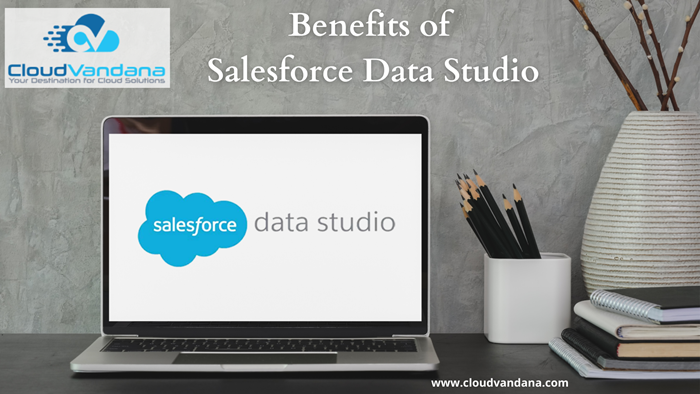
Salesforce Data Studio is a platform where consumer, data owners, and buyers connect directly, creating new marketing opportunities for audiences.Gaining new audiences should be the main aim in the field of marketing. The traditional ways of finding new customers are not cost-friendly and are very complex. Most of the traditional ways of acquiring new customers are not designed for good results for marketers. Collecting data is difficult without the help of middlemen. There should be some better way for this. This is where the importance of Salesforce Data Studio is understood. Salesforce Marketing Cloud provides us with analytics software and services and digital marketing. Marketing Cloud was founded in 2000 under the name ExactTarget. Data Studio is a tool where we can do reporting and a free tool to be used. Salesforce Data Studio is the leading data-sharing platform on the market. It is part of the Salesforce Marketing Cloud. Data Studio helps companies discover new Audiences by allowing data buyers and creators to connect and create marketing opportunities. Salesforce Data Studio serves both buyers and creators. Salesforce Data Studio is a transparent and self-service platform where consumer data owners and buyers connect directly. Data Studio(Data Sharing) is the number one solution in Salesforce for audience discovery, data acquisition, and data provisioning. Data Studio features the world’s largest premium data ecosystem. With the help of Data, Studio marketers can discover and create high-quality audiences. It also helps to monetize your data with complete transparency and control over it, increasing the revenue for data owners. Using Data Studio, we can ensure that your data is protected and provision it at scale to trusted partners with data governance. Benefits of Salesforce Data Studio Expand the reach of the Audience: Salesforce Data Studio helps marketers to pull out the perceptions of existing customers with the latest audience discovery tools. Salesforce Data Studio incorporates over 200 activation channels, which help marketers to reach new audiences easily. Authority on your data: Salesforce Data Studio is the only platform that direct data deals with big dealers.Salesforce Data Studio’s provisioning tools are generated by real data rights management and the convenient reporting and management tools automatically follow with new regulations. Increase revenue: Salesforce Data Studio helps the sellers to get exposed to it’s most profitable set of partners. Sellers can use the tools to share their data directly. Since there is no middlemen involved there will be an undoubtful increase in revenue. What Is Google Data Studio Google Data Studio is a free tool Google used to make personalized reports with data from Google’s Marketing services and external services. Google Data Studio was started as a part of the enterprise Google Analytics 360 suite. Google data studio turns the data into informative easy to use, easy to share. If an organization uses the Salesforce Marketing cloud for marketing automation and Google Data Studio for reporting and analysis, how to get data from the Marketing cloud to the data studio if needed? How to integrate Marketing Cloud with Google Data Studio. Depending on how much data to export from the marketing cloud or how often you need to update reports in a data studio, we can decide on two solutions. Uploading and Exporting Data from Marketing Cloud. Manual Export of your relevant data from the marketing cloud requires a shallow lift connection. This option requires low ongoing maintenance, but the disadvantage is that it is less flexible. The two possible ways to export relevant data from Marketing Cloud are *Use an automated CSV export which can be accessed using FTP. *For more flexibility and control over the exported data, we use Marketing Cloud APIs to Export. Since this is a manual method, we cannot do any automated uploads on a schedule, but we can perform the export process. Connection Service usage We can find many third-party services that offer marketing cloud to Data studio connectors already created in the market. To use this kind of connection, there is no need for any additional development on your organization’s side. In addition, this offers some features to help in replication which will be difficult in manual Export discussed above. Custom Built Connection Solution A customized development upfront is needed with periodic updates and maintenance to create a personalized connection for your organization. A personalized link is most important to have high strength and flexibility. The primary data source for Data studio reports and Dashboards is the Salesforce database. Using SQL queries, we can pull out specific data and use data from the existing accounts. Making a correct balance between Marketing Automation data accessible and controlling the Salesforce Marketing Cloud can be a little tricky. However, many third-party services offer secure processing, including Panoply, Skyvia, and Hevo. Connecting to these services within a few minutes makes it possible to create a secure copy of your data that can be sent to your favorite business intelligence tool. By using these services, your data stays safe, and your team can create reports and dashboards. Are you looking for a Salesforce partner to integrate all these process in a seamless manner? Please feel free to connect CloudVandana and get full ROI Salesforce investment. Request a Free Consultation YOU MIGHT ALSO LIKE
The Importance of Salesforce Opportunity Stages in Your Sales Process
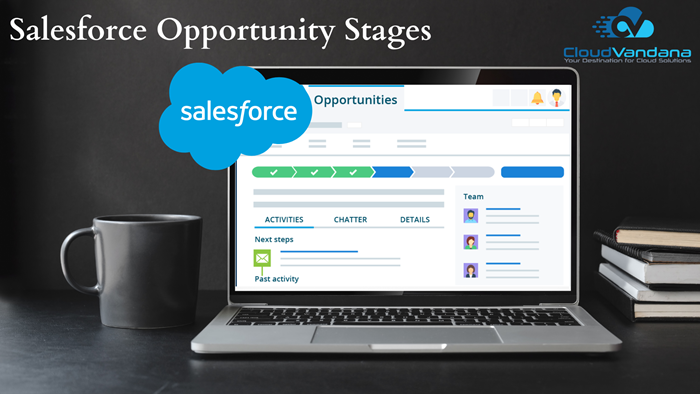
Salesforce opportunity stages describe the high-level phases within the sales process. The opportunity tab in Salesforce captures potential and ongoing deals currently pursued by the sales team in the organization. The Opportunities tab provides holistic progress of each value being followed and helps manage team effort spent per deal. No two sales team members approach the same client for the same opportunity, thus increasing the sales team’s efficiency. Further, since opportunities are tracked on a real-time basis thus each opportunity’s progress is as accurate as it can get, and management can view each opportunity’s progress with accuracy. Every deal undergoes various sales stages as per the organization’s sales process before it is closed; these stages are termed “Opportunity Stages” in Salesforce. It is highly recommended that each business defines and customizes the sales process as per the firm’s business requirements, as shown below. Steps to customize your own sales process Step 1: Go to Setup, search for path settings, and enable “New Path.” Step 2: Select “New Path.” Step 3: List the Path Name and API Reference Name and select “Object Name.” Then, select the “Record Type” and the “Picklist Field” for which you want to customize a new path. Lastly, click on “Next.” Step 4: Customize the “Positions” and “Stages” as per your business requirements. Step 5: Activate your path and click on “Finish” Step 6: You can see the created path from the path settings Conclusion A firm can increase its sales process productivity through Salesforce functionalities by automating various sales stages while pursuing an opportunity. Are you looking for a registered Salesforce partner to get the full benefits of Salesforce CRM? Please feel free to contact CloudVandana and take your organization to the next level. Request a Free Consultation YOU MIGHT ALSO LIKE






